
СТАМБУЛ- Авиакомпания Turkish Airlines (TK) столкнется с растущими проблемами в 2025 году, с эксплуатационными препятствиями и ограничениями флота, влияющими на ее операции в Стамбуле. Запуск дочерней компании AJet (VF) добавляет сложности, поскольку конкуренция и проблемы с обслуживанием угрожают росту.
В 2025 году амбициозная экспансия группы авиакомпаний продолжится под давлением наземных самолетов, растущей конкуренции и эксплуатационных неудач, даже несмотря на то, что ее основные дальнемагистральные и короткие маршруты остаются необходимыми для роста.
В этой статье рассматриваются самые загруженные международные маршруты Turkish Airlines, проблемы с воздушным флотом и эксплуатационные характеристики, основанные на детальном анализе флота и сети по состоянию на март 2025 года.
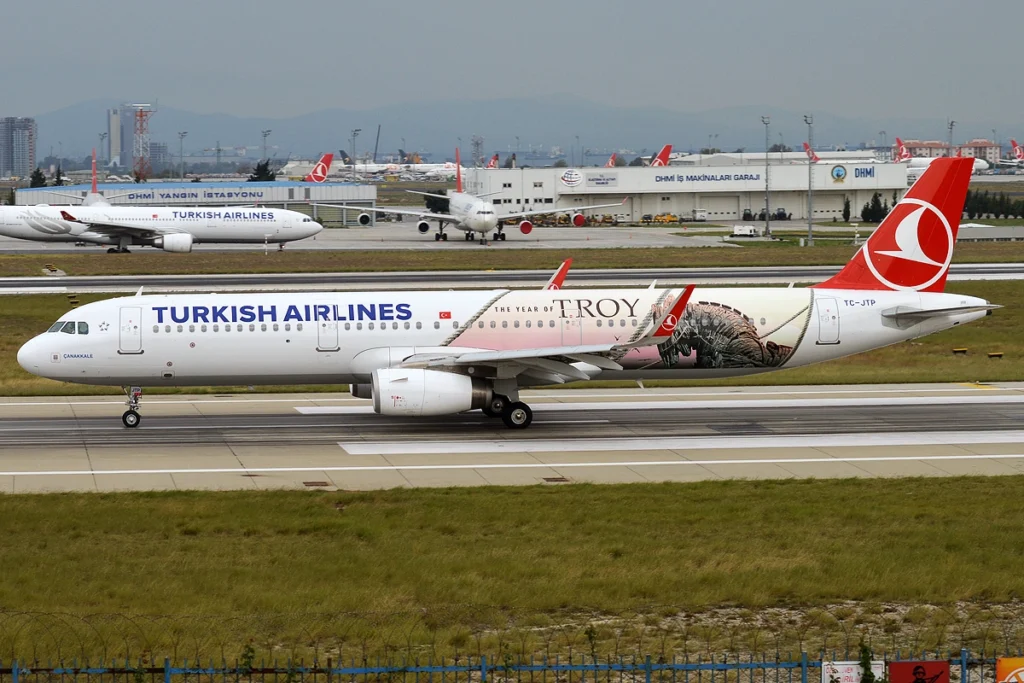 Фото: Анна Зверева из Таллина, Эстония – Turkish Airlines (Год Тройской ливреи), TC-JTP, Airbus A321-231, CC BY-SA 2.0, https://commons.wikimedia.org/w/index.php?curid=73594142
Фото: Анна Зверева из Таллина, Эстония – Turkish Airlines (Год Тройской ливреи), TC-JTP, Airbus A321-231, CC BY-SA 2.0, https://commons.wikimedia.org/w/index.php?curid=73594142Турецкие авиалинии строят самые большие международные маршруты
Turkish Airlines (TK) поддерживает одну из самых обширных международных маршрутных сетей в мире. В 2025 году самые загруженные дальнемагистральные и ближние маршруты Turkish Airlines продолжат стимулировать пассажиропоток, несмотря на проблемы, связанные с эксплуатацией и флотом.
Вот 20 самых загруженных международных маршрутов Turkish Airlines.
| 1 1 | Стамбул-Лондон (IST-LON) | 1 449 000 | 45% | 652 050 | -12% |
| 2 2 | Стамбул-Париж (IST-CDG) | 890 000 | 54% | 480 600 | - 15% |
| 3 | Стамбул-Дубай (IST-DXB) | 848 000 | 34% | 288 320 | - 6% |
| 4.4 | Стамбул-Нью-Йорк (IST-JFK) | 837 000 | 100% | 837 000 | +6,6% |
| 5 | Стамбул-Амстердам (IST-AMS) | 764 тысячи | 54% | 412 560 | -12% |
| 6.6 | Стамбул-Берлин (IST-BER) | 594 тысячи | 57% | 338 580 | -13% |
| 7. | Стамбул-Франкфурт (IST-FRA) | 591 тысяча | 47% | 277 770 | -12% |
| 8 | Стамбул-Джедда (IST-JED) | 585 000 | 41% | 239 850 | +1% |
| 9 9 | Стамбул-Дюссельдорф (IST-DUS) | 557 тысяч | 47% | 261,790 | 17% |
| 1010 | Стамбул-Вена (IST-VIE) | 536 тысяч | 53% | 284 080 | -13% |
| 11. | Стамбул-Мюнхен (IST-MUC) | 521 тысяча | 57% | 296 970 | 17% |
| 12. | Стамбул-Ташкент (IST-TAS) | 509 000 | 49% | 249 410 | - 6% |
| 13 | Стамбул-Бангкок (IST-BKK) | 504 000 000 | 74% | 372 960 | -14% |
| 14 | Стамбул-Милан (IST-MXP) | 496 тысяч | 57% | 282 720 | -13% |
| 15 | Стамбул-Мадрид (IST-MAD) | 476 тысяч | 67% | 318 920 | -1% |
| 16 | Стамбул-Цюрих (IST-ZRH) | 472 тысячи | 57% | 268 040 | -14% |
| 177 | Стамбул-Барселона (IST-BCN) | 464 000 000 | 67% | 311 880 | -3% |
| 18 | Стамбул-Гамбург (IST-HAM) | 460 тысяч | 56% | 257 600 | +3% |
| 19 | Стамбул-Рим (IST-FCO) | 454 000 000 | 55% | 249 700 | -12% |
| 20 | Стамбул-Баку (IST-GYD) | 453 000 | 41% | 185 730 | -18% |
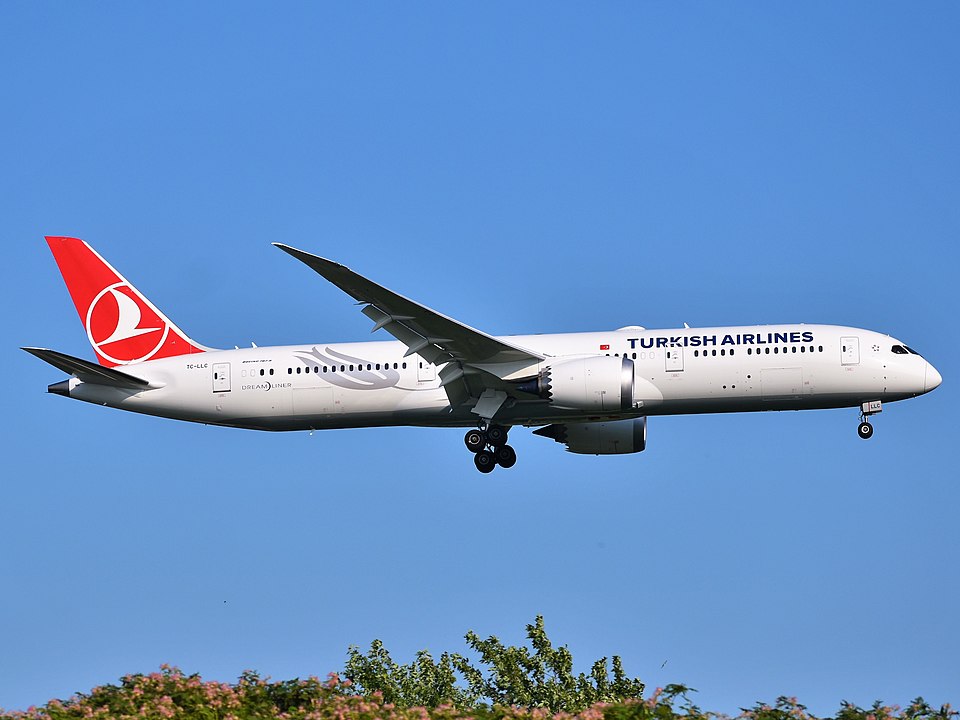 Фото: Адам Морейра (AEMoreira042281) - Собственная работа, CC BY-SA 4.0, https://commons.wikimedia.org/w/index.php?curid=81570442
Фото: Адам Морейра (AEMoreira042281) - Собственная работа, CC BY-SA 4.0, https://commons.wikimedia.org/w/index.php?curid=815704421. Стамбул - Лондон (IST-LON)
- Количество пассажиров1 449 000
- Доля рынка45%
- Пассажиры Turkish Airlines: 652 050
- Темпы роста YoY:-12%
Стамбул-Лондон остается самым загруженным международным маршрутом для Turkish Airlines. Несмотря на 12-процентное снижение общего трафика в годовом исчислении, 45-процентная доля TK подчеркивает ее жизненно важную роль в соединении двух глобальных финансовых и культурных центров.
2. Стамбул - Париж (IST-CDG)
- Количество пассажиров: 890 000
- Доля рынка54%
- Пассажиры Turkish Airlines: 480 600
- Темпы роста YoY:-15%
Стамбул-Париж занимает второе место по объему. Падение на 15% отражает конкурентное давление со стороны европейских перевозчиков, но TK сохраняет контрольную долю, усиливая свою важность на этом ключевом маршруте бизнеса и туризма.
3. Стамбул - Дубай (IST-DXB)
- Количество пассажиров848 000
- Доля рынка34%
- Пассажиры Turkish Airlines: 288 320
- Темпы роста YoY: - 6%
Соединяя два основных ближневосточных хаба, Стамбул-Дубай продемонстрировал скромное снижение трафика на 6%. Треть доли TK подчеркивает интенсивную конкуренцию, но устойчивый спрос на трансфер и отдых в этом стратегическом звене.
4. Стамбул - Нью-Йорк (IST-JFK)
- Количество пассажиров: 837 000
- Доля рынка100%
- Пассажиры Turkish Airlines: 837 000
- Темпы роста YoY+6,6%
Стамбул-Нью-Йорк полностью обслуживается Turkish Airlines. Рост числа пассажиров на 6,6% подчеркивает устойчивый трансатлантический спрос и подтверждает, что этот маршрут является флагманским дальнемагистральным сервисом в сети TK.
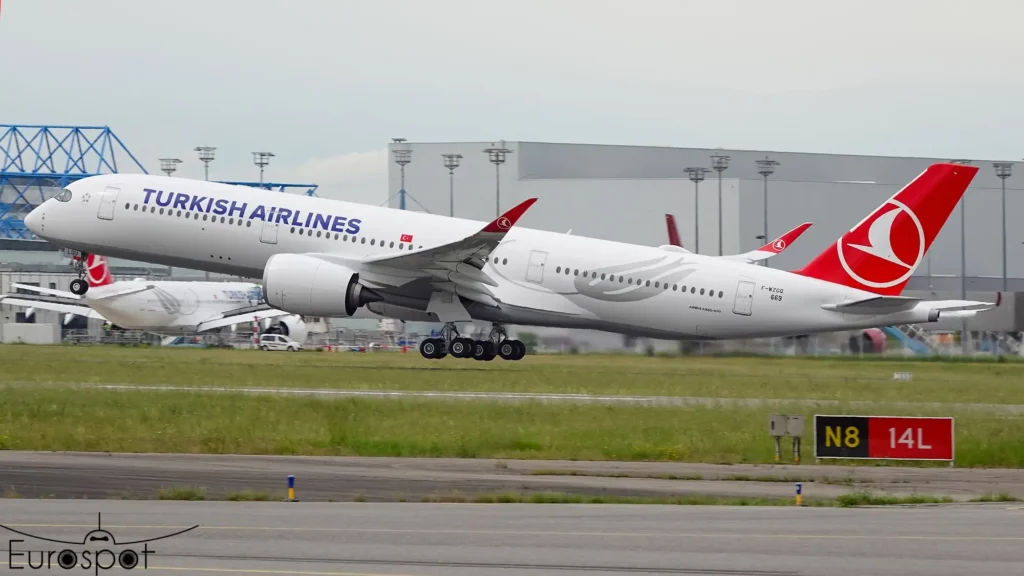 Фото: Eurospot
Фото: Eurospot5. Стамбул - Амстердам (IST-AMS)
- Количество пассажиров764 000
- Доля рынка54%
- Пассажиры Turkish Airlines412 560
- Темпы роста YoY:-12%
Амстердам остается главным европейским направлением. Хотя сегментный трафик упал на 12%, TK поддерживает более половины рынка, обслуживая как деловых, так и туристов в этом высокочастотном коридоре.
6. Стамбул - Берлин (IST-BER)
- Количество пассажиров594 000
- Доля рынка57%
- Пассажиры Turkish Airlines338 580
- Темпы роста YoY:-13%
Стамбул-Берлин входит в число ведущих маршрутов ТК на короткие расстояния. Снижение трафика на 13% отражает экономические препятствия, но 57% акций TK подчеркивает его доминирующее положение на рынках отдыха в Германии и VFR.
7. Стамбул - Франкфурт (IST-FRA)
- Количество пассажиров591 000
- Доля рынка47%
- Пассажиры Turkish Airlines277 770
- Темпы роста YoY:-12%
Франкфурт служит крупным деловым шлюзом. Несмотря на снижение общего объема на 12%, почти половина доли TK демонстрирует устойчивый спрос со стороны корпоративных и подключающих пассажиров.
8. Стамбул - Джидда (IST-JED)
- Количество пассажиров585 000
- Доля рынка41%
- Пассажиры Turkish Airlines: 239 850
- Темпы роста YoY+1%
Этот религиозный Рынок VFR демонстрирует скромный рост. Доля TK в 41% отражает сбалансированную конкуренцию с саудовскими перевозчиками при удовлетворении постоянных потребностей в поездках.
9. Стамбул - Дюссельдорф (IST-DUS)
- Количество пассажиров557 000
- Доля рынка47%
- Пассажиры Turkish Airlines261,790
- Темпы роста YoY:-17%
Стамбул-Дюссельдорф пережил спад на 17%. Тем не менее, TK поддерживает почти половину маршрута, что обусловлено трафиком диаспоры и надежными фидерными соединениями.
10. Стамбул - Вена (IST-VIE)
- Количество пассажиров536 000
- Доля рынка53%
- Пассажиры Turkish Airlines: 284 080
- Темпы роста YoY:-13%
Вена является стратегическим центральноевропейским звеном. Падение сегментного трафика на 13% отражает более широкую мягкость рынка, но основная доля TK подчеркивает его конкурентоспособность.
11. Стамбул - Мюнхен (IST-MUC)
- Количество пассажиров521 000
- Доля рынка57%
- Пассажиры Turkish Airlines: 296 970
- Темпы роста YoY:-17%
Мюнхен является ключевым немецким центром. Резкое снижение на 17% контрастирует с устойчивым доминированием TK на рынке, что подчеркивает устойчивость сети на фоне меняющегося спроса.
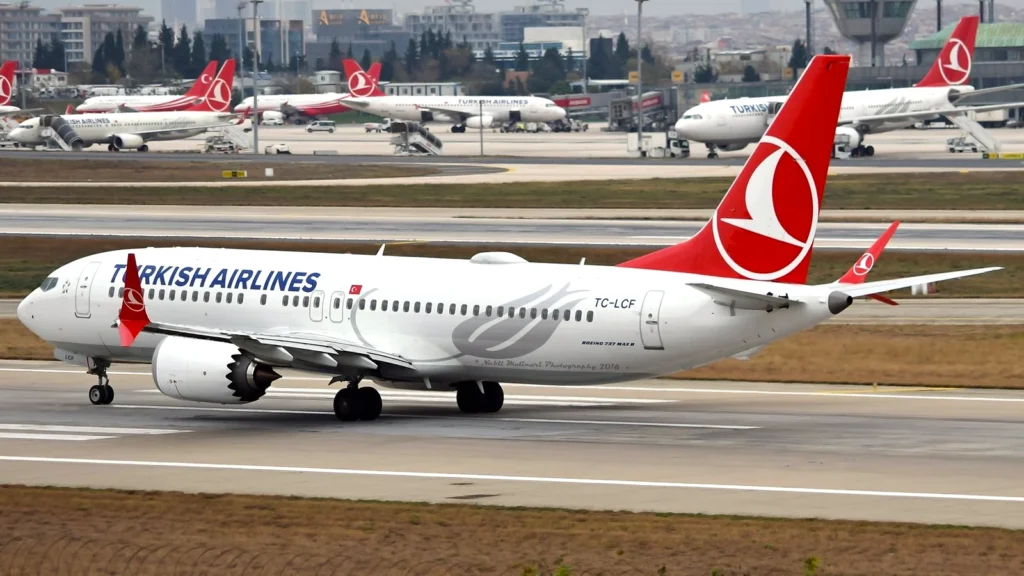 Фото: Набиль Молинари | Flickr
Фото: Набиль Молинари | Flickr12. Стамбул - Ташкент (IST-TAS)
- Количество пассажиров509 000
- Доля рынка49%
- Пассажиры Turkish Airlines: 249 410
- Темпы роста YoY: - 6%
Ташкент является якорем стратегии TK в Центральной Азии. Небольшое падение трафика показывает региональную волатильность, но TK сохраняет почти половину всех путешественников через Стамбул.
13. Стамбул - Бангкок (IST-BKK)
- Количество пассажиров504 000
- Доля рынка74%
- Пассажиры Turkish Airlines: 372 960
- Темпы роста YoY: -14%
Бангкок является главным азиатским дальнемагистральным коротким перекрестком TK. Несмотря на падение на 14%, 74% акций TK подтверждает свое премиальное позиционирование на этом маршруте.
14. Стамбул - Милан (IST-MXP)
- Количество пассажиров496 000
- Доля рынка57%
- Пассажиры Turkish Airlines: 282 720
- Темпы роста YoY:-13%
Милан остается жизненно важным для европейской сети ТК. Умеренное снижение соответствует региональным тенденциям, но авиакомпания сохраняет за собой явную долю в этом коридоре.
15. Стамбул - Мадрид (IST-MAD)
- Количество пассажиров476 000
- Доля рынка67%
- Пассажиры Turkish Airlines: 318 920
- Темпы роста YoY: -1%
Мадрид демонстрирует замечательную стабильность с падением всего на 1%. Сильная доля TK в 67% подчеркивает ее лидирующие позиции в туристических потоках Испании и Турции.
16. Стамбул - Цюрих (IST-ZRH)
- Количество пассажиров472 000
- Доля рынка57%
- Пассажиры Turkish Airlines268 040
- Темпы роста YoY: -14%
Цюрих является основным европейским направлением. Несмотря на снижение на 14%, TK занимает более половины рынка, подчеркивая свою широту в Западной Европе.
17. Стамбул - Барселона (IST-BCN)
- Количество пассажиров464 000
- Доля рынка67%
- Пассажиры Turkish Airlines: 311 880
- Темпы роста YoY: -3%
Барселона является ключевым маршрутом отдыха. Скромный спад на 3% контрастирует с долей рынка TK в две трети, что отражает сильную привлекательность как для туризма, так и для бизнеса.
18. Стамбул - Гамбург (IST-HAM)
- Количество пассажиров460 000
- Доля рынка56%
- Пассажиры Turkish Airlines: 257 600
- Темпы роста YoY+3%
В Гамбурге наблюдается небольшой отскок. Увеличение трафика на 3% и контрольная доля TK свидетельствуют о восстановлении на рынках Северной Европы.
19. Стамбул - Рим (IST-FCO)
- Количество пассажиров454 000
- Доля рынка55%
- Пассажиры Turkish Airlines: 249 700
- Темпы роста YoY:-12%
Рим остается важным досугом и связью VFR. Снижение на 12% соответствует более широкой мягкости на короткие расстояния, хотя TK поддерживает более половины трафика.
20. Стамбул - Баку (IST-GYD)
- Количество пассажиров453 000
- Доля рынка41%
- Пассажиры Turkish Airlines185,730
- Темпы роста YoY: -18%
Баку является основным рынком Кавказа. Снижение на 18% отражает региональную волатильность, но постоянная доля TK в 41% подчеркивает глубину сети.
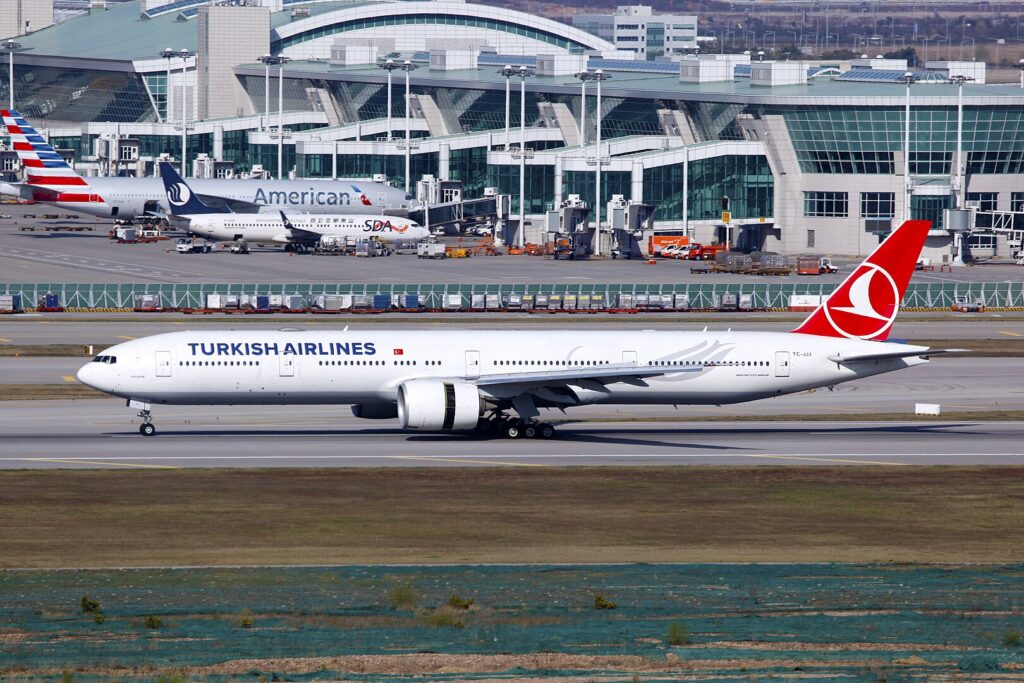 Фото: Byeangel from Tsingtao, China - TC-JJJ | Turkish Airlines | Boeing 777-3F2 (ER) | ICN, CC BY-SA 2.0, https://commons.wikimedia.org/w/index.php?curid=39849224
Фото: Byeangel from Tsingtao, China - TC-JJJ | Turkish Airlines | Boeing 777-3F2 (ER) | ICN, CC BY-SA 2.0, https://commons.wikimedia.org/w/index.php?curid=39849224Маршрутная сеть Turkish Airlines
Turkish Airlines (TK) управляет обширной сетью с 58 миллионами пассажиров в год на ближнемагистральных маршрутах, внося 44% своих доступных километров мест (ASK) и генерируя 6,6 миллиарда долларов дохода от билетов за последние 12 месяцев.
Авиакомпания сталкивается с серьезными проблемами. Запуск AJet (VF) напряг основные операции, отвлекая узкую емкость кузова, в то время как двигатель Pratt & Whitney выпускает заземленные части своего парка Airbus A321neo. Задержки с доставкой Boeing еще больше усложняют планирование парка.
Между тем, конкурент Pegasus Airlines (PC) завоевывает позиции на ультраконкурентном турецком рынке.
В оперативном плане Turkish Airlines борется с недовольством пассажиров из-за задержек, отмен и жалоб на обслуживание, включая сообщения об инцидентах с клопами на дальнемагистральных рейсах.
Компенсационные споры и нехватка рабочей силы в ключевых европейских центрах, таких как Лондонский Хитроу (LHR) и Франкфурт (FRA), усугубляют ситуацию.
Проблемы регулирования на таких рынках, как Дели (DEL) и более медленная, чем ожидалось, интеграция AJet (VF), привели к разочаровывающим финансовым результатам 1-го квартала.
Несмотря на эти препятствия, Turkish Airlines полагается на свое сильное грузовое подразделение и агрессивную стратегию лизинга, чтобы добавить 36 самолетов Airbus в парк AJet.
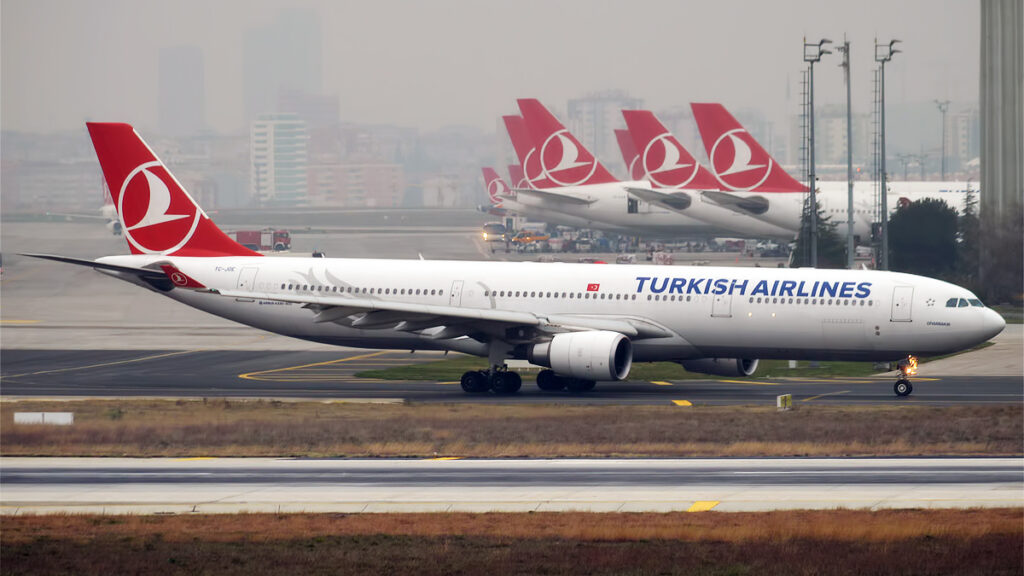 Фото: Анна Зверева из Таллина, Эстония - Turkish Airlines, TC-JOE, Airbus A330-303, CC BY-SA 2.0, https://commons.wikimedia.org/w/index.php?curid=115995460
Фото: Анна Зверева из Таллина, Эстония - Turkish Airlines, TC-JOE, Airbus A330-303, CC BY-SA 2.0, https://commons.wikimedia.org/w/index.php?curid=115995460Флот и производительность сети
Turkish Airlines управляет разнообразным средним/дальнемагистральным флотом, с самолетами, такими как A350-900, A330-300, 777-300, 787-9 и A330-200, оцененными для коммерческих и эксплуатационных характеристик через оценку COFI.
A350-900 набрал 2,6 балла, что отражает проблемы с пассажирами (3,2) и доходом (4,3) на долю рынка, на которую повлияла производительность 5,2.
A330-300 (3.3) и 777-300 (3.5) демонстрируют схожие тенденции, с агрессивностью сети (2.5-3.1) и производительностью выхода (2.6-3.3), что указывает на конкурентное давление.
Флотная композиция
| A350-900 | 24 | 66 | 2,3 года | 327 | Rolls-Royce (RR) |
| A330-300 | 37 | 0 | 11,2 года | 292 | GE / Rolls-Royce |
| 777-300 | 33 | 0 | 11,4 года | 354 | General Electric (GE) |
| 787-9 | 23 | 1010 | 4,2 года | 300 | General Electric (GE) |
| A330-200 | 12. | 0 | 17,1 года | 266 | GE/PW/RR |
| A350-1000 | 0 | 15 | - | - | Rolls-Royce (RR) |
Флот включает в себя 24 А350-900, 37 А330-300 и 33 777-300, с 10 787-9 на заказ. Средний возраст флота колеблется от 4,2 до 17,1 лет, количество мест от 292 до 354.
Типы двигателей варьируются (GE, RR, P&W), при этом проблемы P&W заземляют самолеты A321neo, снижая мощность. 12 A330-200 (17,1 года) набрали 2,4 балла с коэффициентом использования 6,7 самолета.
Возможности возникают из-за сокращения мощностей, вызванного запуском AJet и проблемами с двигателем P&W, которые напрягли дальнемагистральный флот, потеряв долю рынка.
Однако перебалансировка мощностей между узкофюзеляжным и широкофюзеляжным флотами может смягчить это, потенциально улучшив финансовые результаты, начиная с этого года.
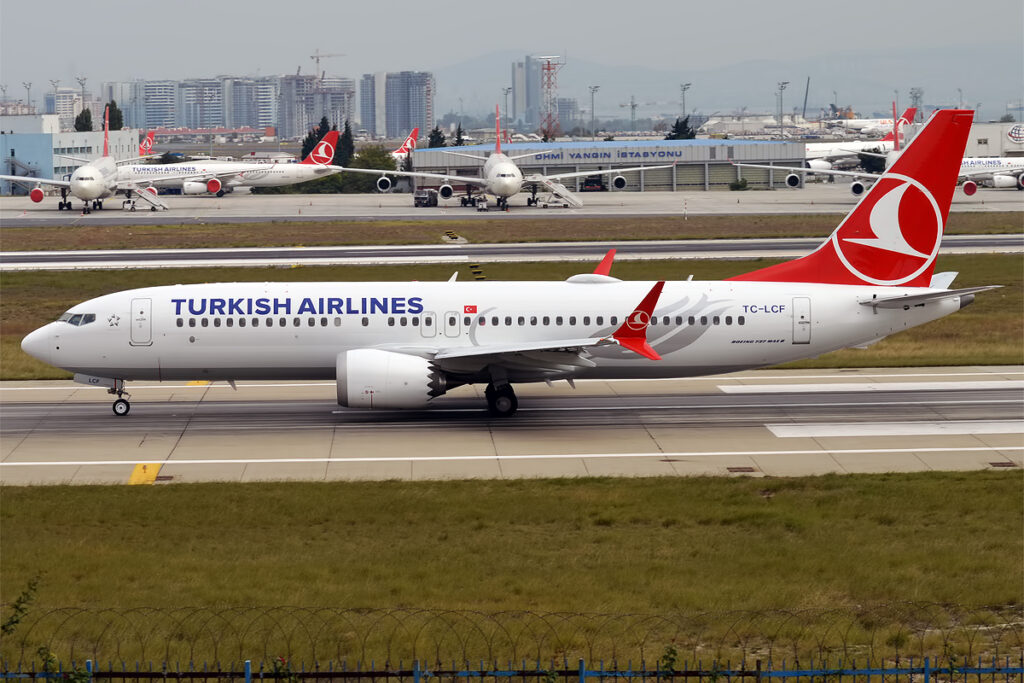 Фото: Анна Зверева из Таллина, Эстония - Turkish Airlines, TC-LCF, Boeing 737-8 MAX, CC BY-SA 2.0, https://commons.wikimedia.org/w/index.php?curid=73594146
Фото: Анна Зверева из Таллина, Эстония - Turkish Airlines, TC-LCF, Boeing 737-8 MAX, CC BY-SA 2.0, https://commons.wikimedia.org/w/index.php?curid=73594146Скриншоты Short-Haul Fleet
| A321neo | 56 | 209 | 3.3 | 185 | PW |
| 737-800 | 40 | 0 | 10.3.3 | 151 | CFM |
| A320neo | 6 (выпущено) | 0 | 2.8 | 186 | PW |
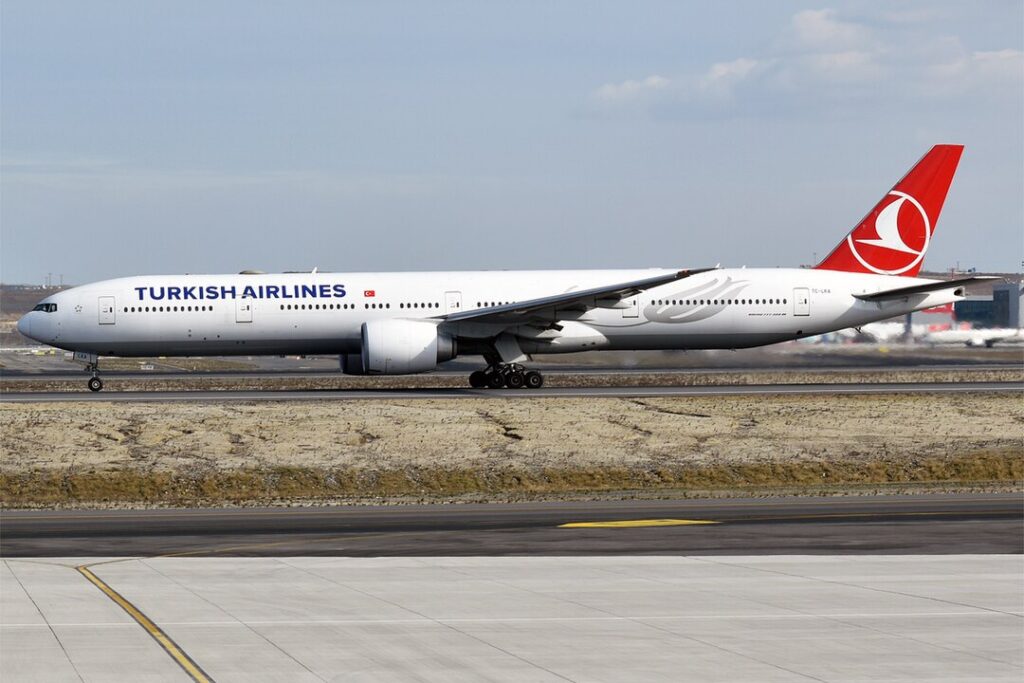 Фото: Анна Зверева из Таллина, Эстония - Turkish Airlines, TC-LKA, Boeing 777-36N ER, CC BY-SA 2.0, https://commons.wikimedia.org/w/index.php?curid=87337852
Фото: Анна Зверева из Таллина, Эстония - Turkish Airlines, TC-LKA, Boeing 777-36N ER, CC BY-SA 2.0, https://commons.wikimedia.org/w/index.php?curid=87337852Лонг-Холм Флит Снэпшот
| A350-900 | 24 | 66 | 2.3 | 327 | Rolls-Royce (RR) |
| 777-300ER | 33 | 0 | 11.4.4 | 354 | ГЕ |
| 787-9 | 23 | 1010 | 4.2.2 | 300 | ГЕ |
Коммерческий и операционный Выступление
Производительность отслеживается с помощью COFI (Commercial & Operational Fit Index), который учитывает такие факторы, как доля рынка, агрессивность сети, стоимость, доходность и использование.
| A350-900 | 2.6 | 3.2.2 | 4.3.3 | 7.2.2 | 6.1.1 |
| A330-300 | 3.3 | 3.9 | 6.0 | 7.3.3 | 6.6.6 |
| 777-300 | 3.5.5 | 4.3.3 | 6.2.2 | 7.3.3 | 6.0 |
| 787-9 | 3.1.1 | 3.4.4 | 5.2.2 | 6.2.2 | 6.6.6 |
| A330-200 | 2.4 | 3.2.2 | 5.8.8 | 8.8.8 | 7.2.2 |
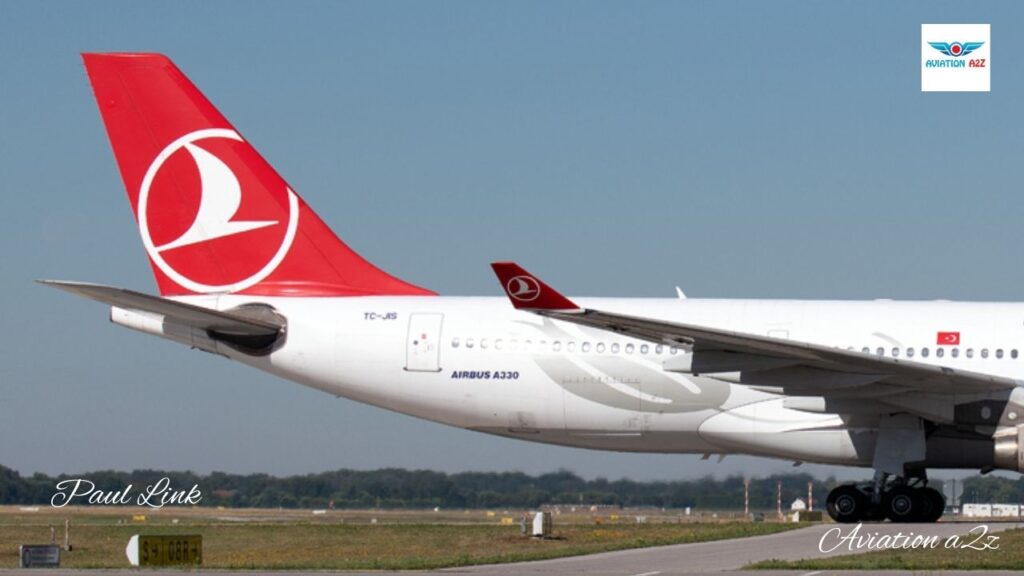 Источник: Paul Link
Источник: Paul LinkОперативные вызовы
Турецкие авиалинии в 2025 году с несколькими встречными ветрами:
- Флот A321neo: Воздействие на Turkish Airlines и AJet из-за проблем с двигателем Pratt & Whitney
- Переключение мощностей на AJet: Сокращение основного питания для дальнемагистральных операций.
- Давление конкурентов: Авиакомпании Pegasus Airlines (PC) и международные перевозчики, такие как Emirates (EK), используют преимущества своего флота.
- Проблемы пассажирского опыта: Сообщения о задержках, отменах и промахах в обслуживании, включая инциденты с клопами, вызвали критику.
- Задержки с доставкой флота: Неудачи Boeing нарушают планирование узкого тела.
- Труд и регулирование Трение: Особенно в Европе и Индии, замедляя рост и интеграцию.
Стратегический прогноз
Несмотря на снижение финансовых показателей в 1 квартале 2025 года, есть признаки восстановления потенциала:
- Коммерческий импульс AJet постепенно набирает силу.
- Широкомасштабные рынки демонстрируют стабильность, особенно на маршрутах США и Восточной Азии.
- Ребалансировка использования парка между узкофюзеляжными и широкофюзеляжными самолетами является ключевой.
- Повышение качества обслуживания и операционной эффективности будет иметь важное значение.
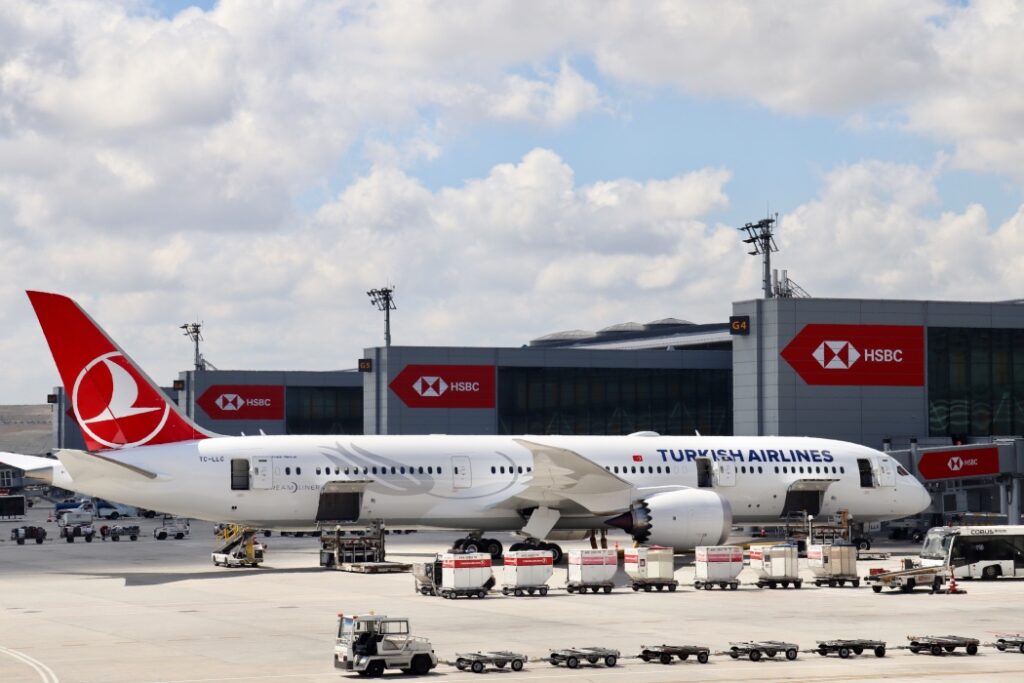 Фото: KM B - собственная работа, CC BY-SA 4.0, https://commons.wikimedia.org/w/index.php?curid=80964383
Фото: KM B - собственная работа, CC BY-SA 4.0, https://commons.wikimedia.org/w/index.php?curid=80964383Источники данных и методология
Данные о самых загруженных международных маршрутах Turkish Airlines предоставляются компанией AvBench. Анализ основан на данных Milanamos (данные о трафике, доходах и расписании) и Ch-aviation (данные флота).
Миланамос предоставляет 1,5 миллиарда записей о местонахождении, 2,4 миллиарда записей о сегменте рейсов и 800 миллионов записей о расписании рейсов, полученных от OAG, IATA BSP, GDS и Airports Council International. Ch-aviation предлагает исчерпывающие данные о флоте, обеспечивая точный контроль.
Оставайтесь с нами. Следуйте за нами в социальных сетях для последних обновлений.
Присоединяйтесь к нам в Telegram Group для последних обновлений авиации. Следуйте за нами в Google News
Турецкие авиалинии провели полудневный бесплатный тур для транзитных пассажиров Стамбула
Пост-турецкие авиалинии в 2025 году, No4 удивят Впервые появился на Aviation A2Z.






